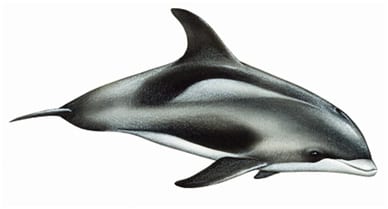White Beaked Dolphin

Fact Sheet
Common Name: White Beaked Dolphin
Scientific Name: Lagenorhynchus albirostris
Length as an adult: 8.25 – 9.25 ft (2.5 – 2.8 m)
Weight as an adult: 395-605 lb (180-275 kg)
Length and weight as birth: 90 lbs (40 kg), 4- 5.5 ft (1.2-1.6m)
Length of pregnancy: 11-12 months
Range: Cool and subarctic waters of the North Atlantic
Likelihood of being seen on a whale watch in Massachusetts coastal waters: Possible but not likely
Preferred food: fish, squid, octopus, krill, and other crustaceans
Unusual characteristics: White or pale gray stripes on each side and behind dorsal fin, also their variable white, dark gray, or mottled brown beaks
Appearance: White, gray, and black very robust body, very prominent fin, pale area on tail stock, white stripe on each side, dark flippers, fin, and flukes.
General Information: Might bow-ride in front of large, fast moving vessels, but usually lose interest quickly. Sometimes they could be acrobatic, especially when feeding. When breaching normally they fall onto their side or back. Typically white beaked dolphins are fast, powerful swimmers and in some parts of range may create a “rooster tail.”
Unusual habits: Swim and feed up-side down
Population status: unknown
Threats: hunting and entanglement
red food: Feed almost exclusively on small, shrimp-like creatures called krill. During the summer feeding season the blue whale eats as much as it possibly can, consuming an astounding 4 tons (3629 kilograms) or more each day. This means it may eat up to 40 million krill a day.
Unusual characteristics: The Blue Whale is the largest animal inhabiting the earth. Its heart is actually around the size of a Volkswagen Beetle. The blue whale produces louder calls than any other animal.
Appearance: The Blue Whale has a long tapered and streamlined body. The rostrum (upper part of the head) is very broad and flat, almost U-shaped, with a single ridge that extends just forward of the blowhole to the tip of the snout.
General Information: These whales are overall blue- gray color. Their dorsal fins are extremely small, and their pectoral flippers are long and thin. Blue whales can reach speeds of 35km per hour.
Unusual habits: Their throats can expand wide enough to hold 256,000 glasses worth of water. As big as they are, they are still able to breach above the water surface.
Population status: Endangered. The Antarctic sub-species is listed as critically endangered. A rough estimate of global population is 10,000 – 20,000.
Threats: Ship strike and entanglement.
References:
- https://www.fisheries.noaa.gov/species/white-beaked-dolphin
- Carwardine, Mark. Whales, Dolphins, and Porpoises. London: Dorling Kindersley, 1995. Illustrated by Martin Camm
- http://www.cms.int
Prepared by: Samantha Santos, NBWM Apprentice 2014
Last modified: April 17, 2020


